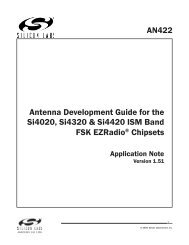C8051F326/7 - Silicon Labs
C8051F326/7 - Silicon Labs
C8051F326/7 - Silicon Labs
You also want an ePaper? Increase the reach of your titles
YUMPU automatically turns print PDFs into web optimized ePapers that Google loves.
<strong>C8051F326</strong>/7<br />
12.1. Endpoint Addressing<br />
A total of three endpoint pipes are available. The control endpoint (Endpoint0) always functions as a<br />
bi-directional IN/OUT endpoint. Endpoint 1 is implemented as a 64 byte IN pipe and a 128 byte OUT pipe:<br />
12.2. USB Transceiver<br />
Table 12.1. Endpoint Addressing Scheme<br />
Endpoint Associated Pipes USB Protocol Address<br />
Endpoint0<br />
Endpoint0 IN<br />
Endpoint0 OUT<br />
0x00<br />
0x00<br />
Endpoint1<br />
Endpoint1 IN<br />
Endpoint1 OUT<br />
0x81<br />
0x01<br />
The USB Transceiver is configured via the USB0XCN register shown in Figure 12.1. This configuration<br />
includes Transceiver enable/disable, pullup resistor enable/disable, and device speed selection (Full or<br />
Low Speed). When bit SPEED = ‘1’, USB0 operates as a Full Speed USB function, and the on-chip pullup<br />
resistor (if enabled) appears on the D+ pin. When bit SPEED = ‘0’, USB0 operates as a Low Speed USB<br />
function, and the on-chip pullup resistor (if enabled) appears on the D- pin. Bits4-0 of register USB0XCN<br />
can be used for Transceiver testing as described in Figure 12.1. The pullup resistor is enabled only when<br />
VBUS is present (see Section “5.2. VBUS Detection” on page 31 for details on VBUS detection).<br />
Important Note: The USB clock should be active before the Transceiver is enabled.<br />
88 Rev. 1.1


